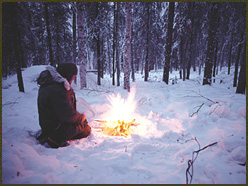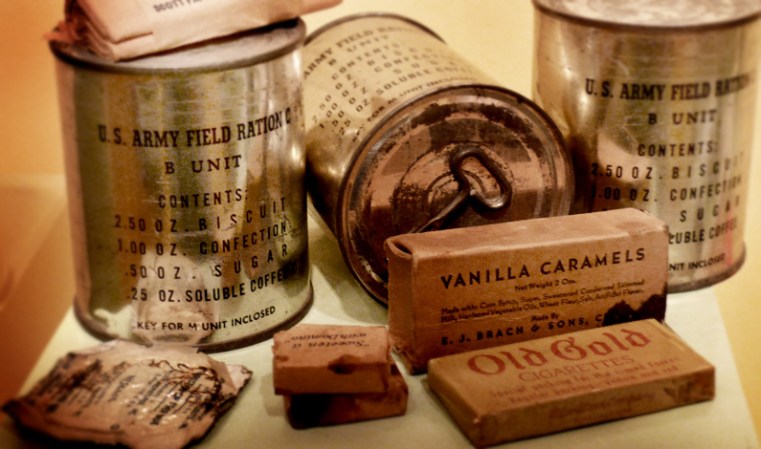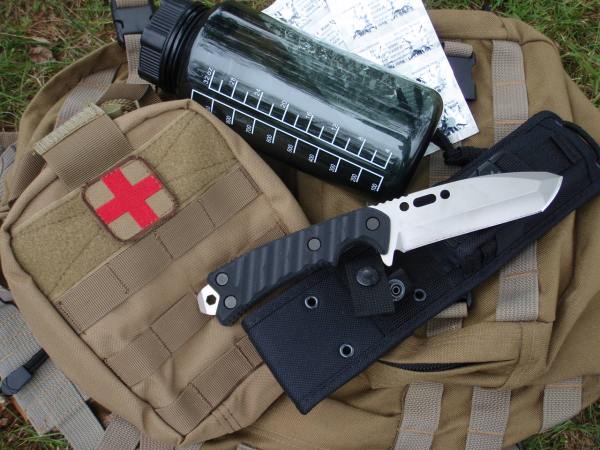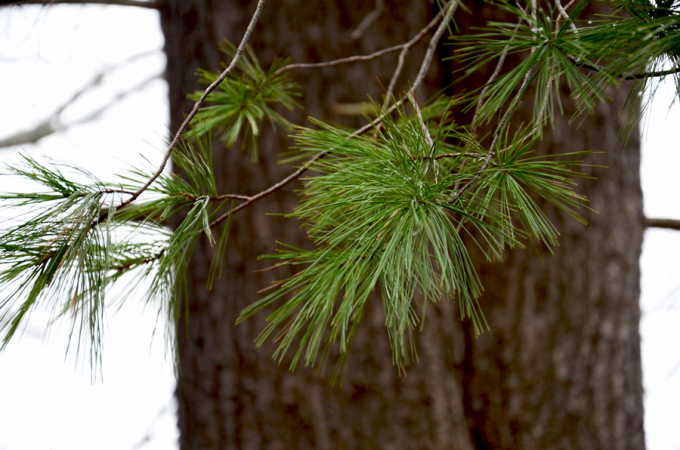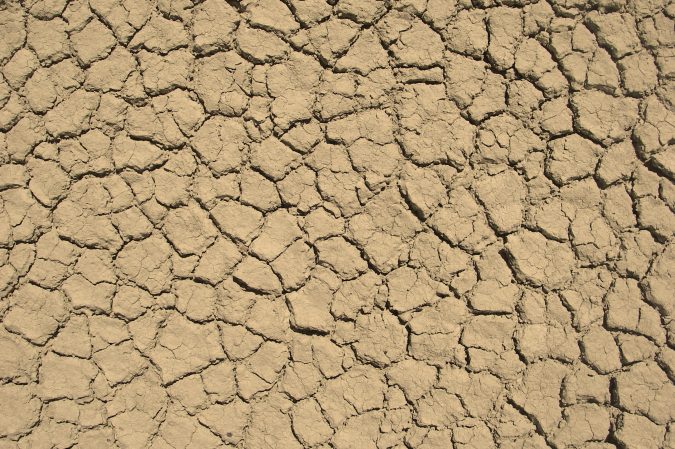Of the many trophies I’ve received in my life, I am most proud of the ugly, L-shaped scar I carry on my back. One second Larry Suiter and I were afloat off the Kodiak Island shoreline, celebrating a successful November deer hunt over dinner. Without warning, an unexpected gale flipped our 38-foot charter boat, slamming us into the galley wall. The howling wind was ground into background noise by the sound of the overturning boat being crunched like a metal can in a vice. Struggling to emerge from an avalanche of gear, I wiggled my back off a piece of angle iron that I had landed on, and the wound began bleeding profusely. My discolored left arm was limp and had no feeling.
Larry grabbed what gear he could and helped me into a survival suit. The boat floundered on its side as foaming salt water rushed in the portals and floated our equipment. The water rose to our waists; the galley lights flickered and popped. We crawled through a horizontal door and didn’t look back as a gust spiked us into the frothy sea. We swam for our lives.
A cresting breaker kicked us onto the beach like an invisible foot. Gusts hammered us into the icy gravel as we half-walked, half-crawled up the long spit, beyond the reach of the incoming tide. Once we were there, the storm intensified. We could neither build a fire nor erect our tent. There were no trees for a windbreak. We crawled into a shallow depression on the bank and wrapped ourselves in space blankets to escape the biting sting of snow and hail. Halfway through the night, I had to relieve myself. The unrelenting gale kept me from standing and forced me to urinate while lying on my side. The cold had slowed the bleeding on the wound, now a hard and jagged-edged lump protruding grotesquely near my spine. A baseball-sized bulge-purple and red with pain-now appeared on my useless left arm. We both knew what we had to do. Holding on was the tough part. Fourteen hours later, the storm had partially subsided, and we had a small fire going. As I tended to my injuries, Larry gathered up the gear that had floated to shore. The rising sun warmed my skin, but it was the Coast Guard rescue helicopter hovering into view that torched my heart with the fire of victory. We walked the 100 yards to the rescuers with pride, knowing we did it right.
Reading survival stories can be thrilling, but real-life cold-weather survival sucks. Building snow caves and searching for food is tough when your stomach is growling and you’re weak or injured from loss of blood. You begin to wonder how severe your injuries are, whether you’ll survive and whether you’ll see your family again. With today’s GPS equipment, ending up in a survival situation is rarely the result of being lost, but rather the unexpected consequences of injury or weather, mechanical failure, hunting too far from base camp or experiencing a mishap like an overturned boat or a fall through the ice.
You may never lose your life to exposure, but losing toes and fingers to frostbite is a lifelong embarrassment and telltale sign that you lost the “cold war.” Preparation and know-how are weapons you use to defeat the cold. Here’s how to be the victor rather than victim.
Mental Conditioning
Cold will both physically disable you and short-circuit your power of reason. If you are immersed in icy water or have twisted an ankle in an avalanche chute, your first priority is to remove yourself from immediate danger. A can-do attitude fueled by anger, religious faith or pure stubbornness is one of your most important weapons in the fight to make it out of your predicament in one piece. Next, stabilize any injuries with first aid. If you are lost, sit down and examine your options.
Hold Onto Your Heat
Maintaining your body’s core temperature is now your key concern. You’ll lose heat up to 25 times faster in damp or wet clothing. So build a fire, remove youclothing, dry off and wrap yourself in a space blanket while your clothes dry. If starting a fire isn’t an option, wring out your clothes (hopefully, you’ll be clad in moisture-wicking synthetics) and allow your body heat to dry them. Excess moisture on your lips, hands and face also expedites heat loss. Wipe these areas dry and apply lotion or protective lip balm with sunscreen to exposed areas.
Feet are the most vulnerable part of your body to cold. Two men who crash-landed their plane in winter used a fire to dry out their sleeping bags and coats each night, but neglected to dry out their socks and footgear. The dampness and cold temperatures resulted in gangrene and infection and the amputation of several toes.
Dry your feet whenever they are wet, and wipe out the inside of your boots. Loosen your shoelaces. Wet, constrictive boots and ill-fitting socks restrict circulation and can lead to frostbite. Wiggling your toes and moving your feet generates warmth. (Rocks warmed by a fire, wrapped in foil and placed in your footgear can help dry your boots.)
Cinch your coat tight around the neck and waist to reduce the bellows effect, which is when cold air travels up underneath a coat and chills you. This is a major cause of lost upper body heat.
Air-activated heat pads can maintain an average temperature of 104 to 137 degrees for 6 to 12 hours. Place them around your kidneys, on your wrists or in your shoes. Don’t get too warm, however. Staying slightly chilly promotes the highest efficiency of your body’s heat-production processes.
Keep Hydrated
Consuming adequate amounts of water (5 to 6 quarts a day) is a key to survival in cold weather. If your urine is dark yellow, or if you haven’t urinated in some time, you are not drinking enough. A good rule of thumb is to drink one cup of water every hour you’re awake. After taking a drink, fill your water bottle’s open air space with snow and tuck it close to your body. Body heat will melt the snow, providing you with an emergency supply of drinkable water.
If you find a conventional source of water nearby, filter or treat it and drink up. If you’re relying on melted snow, keep in mind that it takes 10 cups of snow to yield one cup of water, so you’ll need to make several snow-melting devices to stay hydrated. (One advantage to melting snow, however, is that it is clean enough that you don’t need to purify or treat the water.)
If the snowmobile, airplane or truck engine is still hot, fill a pop can or metal cup with snow and place it on the exhaust manifold. If the sun is shining, take a black plastic trash bag or air mattress, tilt it toward the sun and make a crease leading toward your drinking cup. Dust the mattress or bag lightly with snow, allowing some of the black to show. The dark color absorbs heat, which melts the snow and sends water trickling into your drinking cup. Transfer the water to your canteen before it freezes. eat for energy In extreme cold, you’ll need to consume about 4,500 calories daily, in addition to drinking enough water to process those calories, to maintain body strength for the hike to base camp or to collect food.
The cold-weather rations issued by the U.S. government are the best source of food for a cold-weather emergency. Labeled as Meals, Cold Weather-MCW for short-each meal is sealed in a waterproof, airtight container and does not require cooking. The heavy-duty plastic bag the meal comes in can be used as a water container and each package has matches, toilet tissue, cookies, soup, candy, an entree, crackers and other foods to provide your 4,500 calories. If you have trouble finding these rations (eBay is about the only place they’re available), simply take three standard Meals Ready to Eat (MREs) for your daily rations. One advantage to the cold weather meals is that they limit the protein content and sodium to 5 grams per ration to reduce the risk of dehydration. If you decide to create your own meal pouches, emulate the MCW mix of about 4,500 calories in a blend of 8 percent protein, 32 percent fat and 60 percent carbohydrates.
Plan on eating small meals throughout the day. This will provide you with the energy to build water generators, set snares and keep you thinking coherently until you can supplement your food with wild game. Once you get wild game, consume it first, but continue to eat some survival rations as well. Mixing the foods allows your body to adjust to the new wild-game diet and will help stave off cramps and diarrhea, which causes dehydration.
I was once stranded for 10 days on a moose hunt. I created hobo pemmican by rendering moose fat in a pan, adding chopped moose meat, frozen berries and crackers. I scored and pressed the fat to prevent it from burning in my metal cup. The temperature hovered around 15 degrees, but because of the calories from my food, I didn’t get cold once.
Take Cover
In subzero snowy conditions you’ll be more comfortable in a thermal shelter than you will be spending the night under a tarp or in an uninsulated vehicle. A thermal shelter is fast and easy to build and, properly constructed, will warm the inside air to 18 to 22 degrees Fahrenheit.
To build a snow shelter, shovel and scrape through the snow, creating an oval patch of bare ground that is 2 feet longer than your height. Build a framework of branches over the oval, leaving about 3 feet of space between the ground and the interior ceiling. Create an opening at one end for an entryway. Place plastic sheeting over the framework and cover it with 18 inches of snow. The shelter is ready to use. Fill a plastic bag or tarp with snow and stuff it into the opening to form-fit. The snow will harden, creating a plug for your “door.” Chip a small vent for air exchange.
In freezing rain or in snowless terrain, build a lean-to out of a tarp and spruce boughs. Use an uprooted tree as an anchor. Build a fire, stacking logs behind it to reflect heat into the shelter. In treeless terrain a poncho with corner grommets can serve as a makeshift teepee-style one-person shelter.
Before Turning In
You’ve tended to your injuries, made yourself warm, gathered water and built a shelter. As you eat your evening meal, kick back by the fire and make the best of your situation. Keep your headlamp and water bottle in a warm inner pocket for quick access. Store your extra water under at least 2 feet of snow with the spouts of the containers pointed down to prevent them from freezing. Remember to leave some air space in your canteen to compensate for the expansion of ice.
More than half of your body heat is lost through your head, so wear a hat, pull up your hood and exercise to just shy of the point of perspiration toto reduce the risk of dehydration. If you decide to create your own meal pouches, emulate the MCW mix of about 4,500 calories in a blend of 8 percent protein, 32 percent fat and 60 percent carbohydrates.
Plan on eating small meals throughout the day. This will provide you with the energy to build water generators, set snares and keep you thinking coherently until you can supplement your food with wild game. Once you get wild game, consume it first, but continue to eat some survival rations as well. Mixing the foods allows your body to adjust to the new wild-game diet and will help stave off cramps and diarrhea, which causes dehydration.
I was once stranded for 10 days on a moose hunt. I created hobo pemmican by rendering moose fat in a pan, adding chopped moose meat, frozen berries and crackers. I scored and pressed the fat to prevent it from burning in my metal cup. The temperature hovered around 15 degrees, but because of the calories from my food, I didn’t get cold once.
